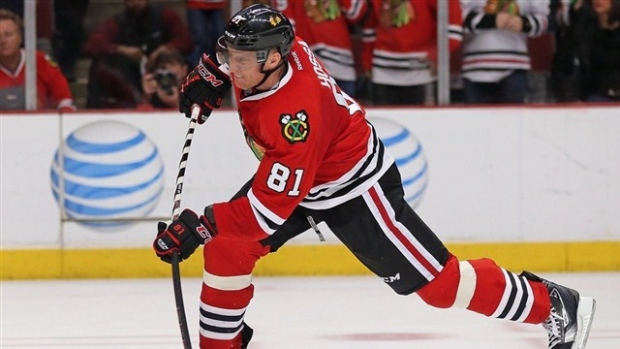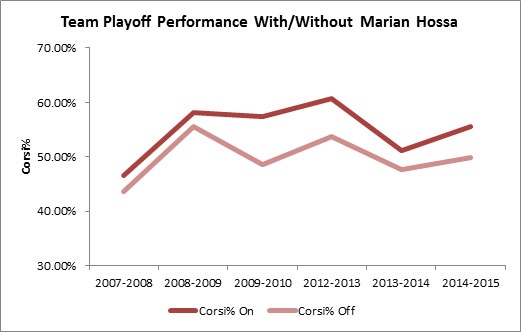Jun 11, 2015
Hossa a force in a young man's game
Hockey is a young man's game, as evidenced by the Stanley Cup Final series between the Chicago Blackhawks and Tampa Bay Lightning, but that only deepens Travis Yost's appreciation for Marian Hossa.
By Travis Yost

Watching this year’s Stanley Cup Final, you are again reminded that hockey has more or less become a young man’s game. The upstart Tampa Bay Lightning are led by a bunch of 20-somethings, and even the dynastic, been-around-forever Chicago Blackhawks still have plenty of miles left. The franchise cornerstones in the Windy City run 26 (Kane) and 27 (Toews), and the next wave of talent runs 22 (Saad) and 20 (Teravainen).
It’s for this exact reason that I continue to be so impressed by grizzled veteran Marian Hossa, who turned 36-years-old this past January. I’m not exactly sure if the nickname “Mr. June” has been bestowed on anyone in hockey yet, but if we are ready to knight someone, it probably should be Hossa.
In the “analytics era”, which runs from the 2007-2008 season through present day, no player has seen more post-season hockey than Marian Hossa. And, really, it’s not close. Hossa’s logged a whopping 137-games through a combination of runs with Pittsburgh, Detroit, and now Chicago – the next closest would be Mike Richards at 118, followed by Jonathan Toews and Patrick Sharp at 115 apiece.
There have been excruciating miles logged on the Slovak’s body, but it seems to do little but energize him. This Stanley Cup Final has been another display of his wizardry – he jumpstarts wave after wave of offense, is as reliable a two-way forward as you’ll find in the league, and still has a ridiculous combination of speed and strength that allows him to flourish against significantly younger talent. Watching his battles against the venerable Victor Hedman in particular has been a treat, if only to watch Hedman – a player rarely bettered – struggle to deal with Hossa’s versatility.
I mentioned the “Mr. June” and analytics era stuff earlier for a reason, because I wanted to circle back on some of his ridiculous underlying numbers over the years, and how it legitimizes what the eye test tells us – he’s always in the offensive zone, and beating him back into the defensive zone is an absurdly difficult task.
Look at his Corsi splits in the six years his teams have went deep in the post-season, and notice how his teams are appreciably better with him on the ice:

The disparities are amazing, particularly so over the last couple of years, as Hossa’s aged into his twilight years. You’ll note that this year is no exception – the Blackhawks have been rather ordinary with him off of the ice, but an elite hockey team with him on the ice. And this is against stellar competition, be it the three Western Conference teams they knocked off or Tampa Bay in the Final.
Hossa’s numbers this year – much like every other year, save the weird 2007-2008 Pittsburgh team – are dominant. The Blackhawks have earned about 56% of the shot-attempts with Hossa on the ice, which is neck-and-neck with Victor Hedman for the best number a skater has produced this post-season.
Should Hossa finish with the best Corsi% of the playoffs, he’ll have done so for the third time in eight possible seasons. His 58.1% in the 2008-2009 playoffs and his 58.1% in the 2009-2010 playoffs were, also, the best number posted by any regular skater. And, had it not been for the brilliance of Jonathan Toews in 2012-2013, Marian Hossa would’ve finished with the single best number that post-season, too.
Ultimately, though, what we care about are goals. The shot differentials are great, but have they led to a favourable goal differential with Hossa over the years at 5-on-5? A great question, with an easy answer:
MARIAN HOSSA, GOAL PERCENTAGE
|
YEAR |
GOAL% |
|---|---|
|
2007-2008 |
60.0% |
|
2008-2009 |
62.5% |
|
2009-2010 |
61.3% |
|
2012-2013 |
71.4% |
|
2013-2014 |
50.0% |
|
2014-2015 |
56.0% |
You read this as follows: the opposition, collectively, has never outscored Marian Hossa’s line in the analytics era.
Mr. June? Yeah, I’m cool with that nickname.



